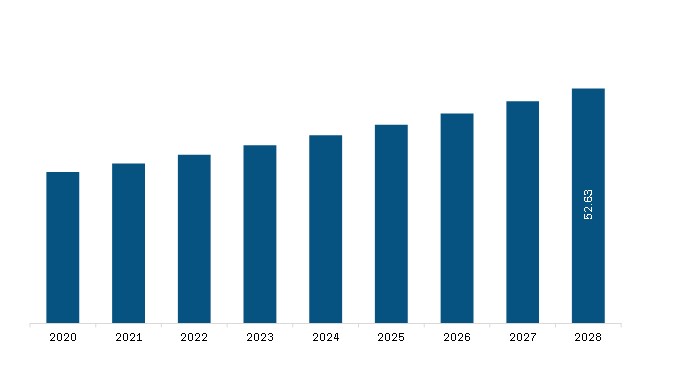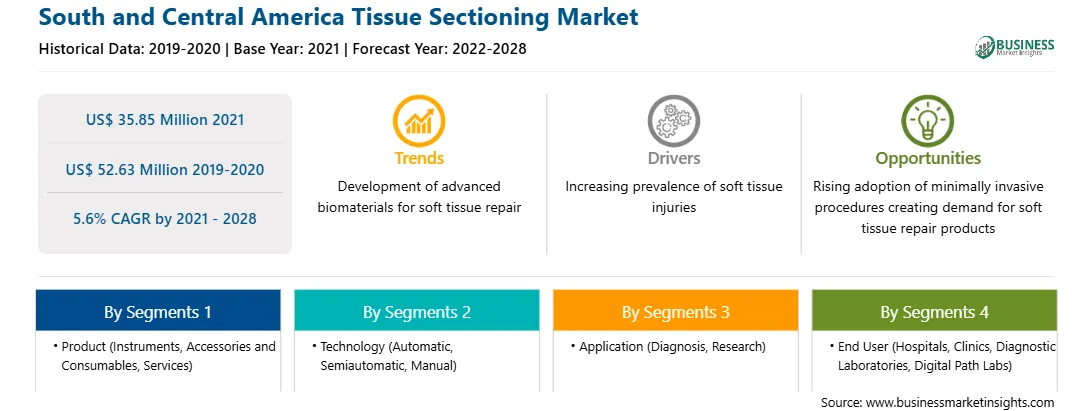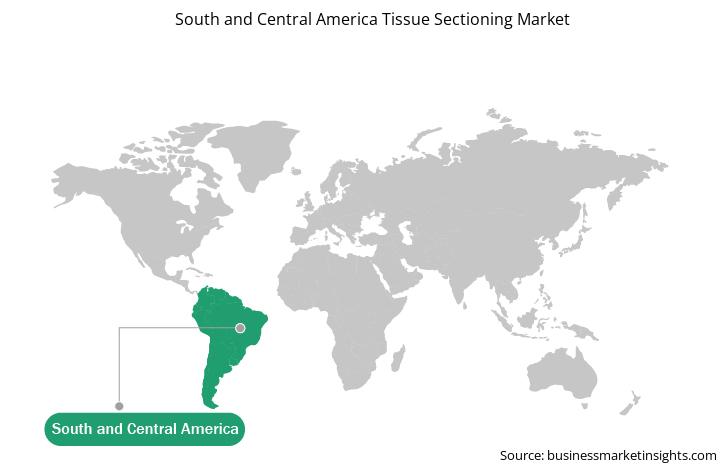Market Introduction
Tissue sectioning is a procedure that involves cutting tissues into thin sections so that they can be placed on a slide and then mounted under a microscope for study. It is used to examine tissue in order to detect any abnormalities or disease conditions. It is employed in histology laboratories, science laboratories, and other settings. Tissue processing is carried out after it has been examined between tissue embedding and fixation. Frozen sectioning and paraffin sectioning are the two types of tissue sectioning. It is used to detect breast nodules to determine whether a mastectomy is necessary, as well as to treat congenital megacolon in children and newborns. For advanced analysis, the tissues to be sectioned must be cut into very thin pieces or sections, i.e., 5-10 micrometer or smaller portions.
Strategic insights for the South and Central America Tissue Sectioning provides data-driven analysis of the industry landscape, including current trends, key players, and regional nuances. These insights offer actionable recommendations, enabling readers to differentiate themselves from competitors by identifying untapped segments or developing unique value propositions. Leveraging data analytics, these insights help industry players anticipate the market shifts, whether investors, manufacturers, or other stakeholders. A future-oriented perspective is essential, helping stakeholders anticipate market shifts and position themselves for long-term success in this dynamic region. Ultimately, effective strategic insights empower readers to make informed decisions that drive profitability and achieve their business objectives within the market. The geographic scope of the South and Central America Tissue Sectioning refers to the specific areas in which a business operates and competes. Understanding local distinctions, such as diverse consumer preferences (e.g., demand for specific plug types or battery backup durations), varying economic conditions, and regulatory environments, is crucial for tailoring strategies to specific markets. Businesses can expand their reach by identifying underserved areas or adapting their offerings to meet local demands. A clear market focus allows for more effective resource allocation, targeted marketing campaigns, and better positioning against local competitors, ultimately driving growth in those targeted areas.
South and Central America Tissue Sectioning Strategic Insights

South and Central America Tissue Sectioning Report Scope
Report Attribute
Details
Market size in 2021
US$ 35.85 Million
Market Size by 2028
US$ 52.63 Million
Global CAGR (2021 - 2028)
5.6%
Historical Data
2019-2020
Forecast period
2022-2028
Segments Covered
By Product
By Technology
By Application
By End User
Regions and Countries Covered
South and Central America
Market leaders and key company profiles
South and Central America Tissue Sectioning Regional Insights

Market Overview and Dynamics
The South and Central America tissue sectioning market is expected to reach US$ 52.63 million by 2028 from US$ 35.85 million in 2021. It is estimated to grow at a CAGR of 5.6% from 2021 to 2028. The increasing prevalence of chronic diseases and the rising adoption of personalized medicines are propelling this regional market. However, the lack of skilled professionals is expected to restrict the market growth during the forecast period.
Under the Ministry of Health and Family Welfare (MoHFW) and the Government of India, the NHM backed all states to provide essential diagnostics at their public health installations free of cost in India. Taking this initiative to global position, the WHO released the original edition of the Essential Diagnostics List (EDL) in May 2018. Fastening on the significance of diagnosis, the WHO stated the testing affects the majority of medical opinions. Appropriate diagnostic tests can inform evidence-based treatment and accountable use of medicines, performing in the overall bettered allocation of resources and better health outcomes.
With a remarkable rise in the aging population, several chronic ailments cases are showing an increase, leading to the necessity toward prevention and cure from a disorder, and, hence, the medical decision. Tissue sectioning (including necropsies, surgical or necropsy samples) is a core part of histopathological examinations, on which the physicians can blindly rely for the result accuracy. The superficial tissue sections may not represent the whole necropsy, which leads to repeated requests for deeper sections to enhance sensitivity and diagnostic delicacy. The data mentioned above and factors are performing in an increase in the number of remedial establishments. For illustration, pathology laboratories and clinics have increased the appropriation of tissue sectioning. These developments and rapid adoption are shifting the focus of pathologists and researchers toward exploring other approaches. Also, this massive contribution to ineffective treatments with the aid of histopathological examination is a significant factor in the growth of the tissue sectioning market.
South and Central America has been witnessing a significant number of COVID-19 cases; the increasing number of cases in Brazil, Peru, Chile, Ecuador, and Venezuela is likely to impact the market negatively. A considerable number of countries in South America have very underdeveloped healthcare infrastructure. For instance, Peru has less than 1000 intensive care unit beds for its 32 million inhabitants. Furthermore, supply chain disruption caused due to congestion of ports and disturbances in other transport means had a substantial impact on the distribution of associated devices in the region. As the focus on COVID-19 patients became critical, the non-urgent medical procedures took a back seat. Several clinics have postponed or dropped numerous elective surgeries, especially those considered non-urgent. The markets associated with tissue sectioning, such as histopathological diagnosis, would be severely affected. All these factors considerably deterred the growth of the South and Central America tissue sectioning market. However, the number of tissue sections again started to gain momentum as the number of COVID-19 confirmations declined.
Key Market Segments
Based on the product, the South and Central America tissue sectioning market is segmented into instruments, accessories & consumables, and services. The instruments segment is further sub-segmented into rotary microtome, ultramicrotome, cryostat, sliding microtome, and others. In 2021, the instruments segment held the largest share of the market. The accessories and consumables segment is expected to grow at the fastest CAGR during the forecast period.
Based on the technology, the South and Central America tissue sectioning market is segmented into automatic, semiautomatic, and manual. The automatic technology segment held the largest share of the market in 2021, and the same segment is estimated to register the highest CAGR in the market during the forecast period.
Based on the application, The South and Central America tissue sectioning market is segmented into diagnosis and research. In 2021, the diagnosis segment accounted for the largest share of the market. The research segment is expected to witness the fastest CAGR from 2021 to 2028.
Based on the end user, the South and Central America tissue sectioning market is segmented into hospitals, clinics, diagnostic laboratories, digital path labs, and others. In 2021, the hospitals segment led the global market. However, the diagnostic laboratories segment is expected to report the fastest CAGR from 2021 to 2028.
Major Sources and Companies Listed
Some of the primary and secondary sources associated with this report on the South and Central America tissue sectioning market are the Center for Disease Control and Prevention (CDC) and Pharmaceutical Research and Manufacturers Association (PhRMA).
Reasons to buy the report
SOUTH AND CENTRAL AMERICA TISSUE SECTIONING MARKET SEGMENTATION
By
Product
By
Technology
By Application
By End User
• Hospitals
• Clinics
• Diagnostic Laboratories
• Digital Path Labs
By Country
Company Profiles
The South and Central America Tissue Sectioning Market is valued at US$ 35.85 Million in 2021, it is projected to reach US$ 52.63 Million by 2028.
As per our report South and Central America Tissue Sectioning Market, the market size is valued at US$ 35.85 Million in 2021, projecting it to reach US$ 52.63 Million by 2028. This translates to a CAGR of approximately 5.6% during the forecast period.
The South and Central America Tissue Sectioning Market report typically cover these key segments-
The historic period, base year, and forecast period can vary slightly depending on the specific market research report. However, for the South and Central America Tissue Sectioning Market report:
The South and Central America Tissue Sectioning Market is populated by several key players, each contributing to its growth and innovation. Some of the major players include:
The South and Central America Tissue Sectioning Market report is valuable for diverse stakeholders, including:
Essentially, anyone involved in or considering involvement in the South and Central America Tissue Sectioning Market value chain can benefit from the information contained in a comprehensive market report.